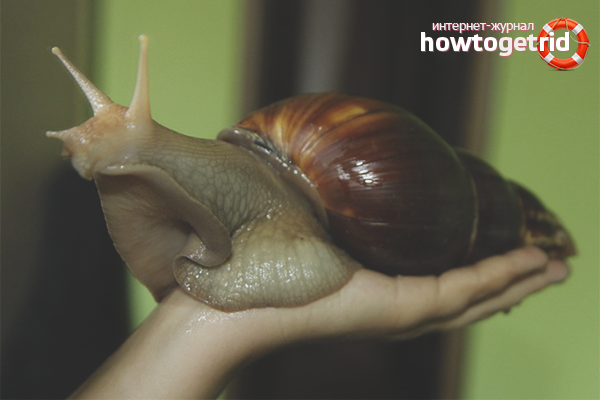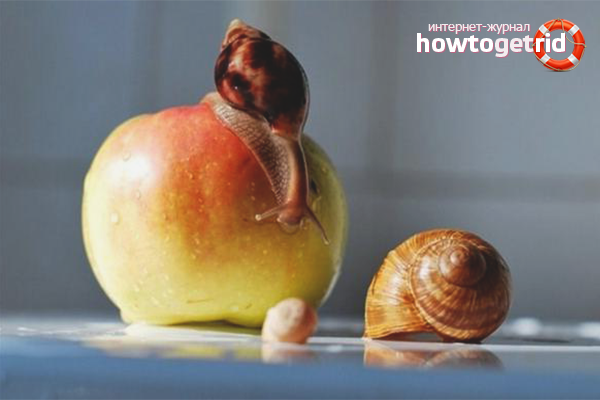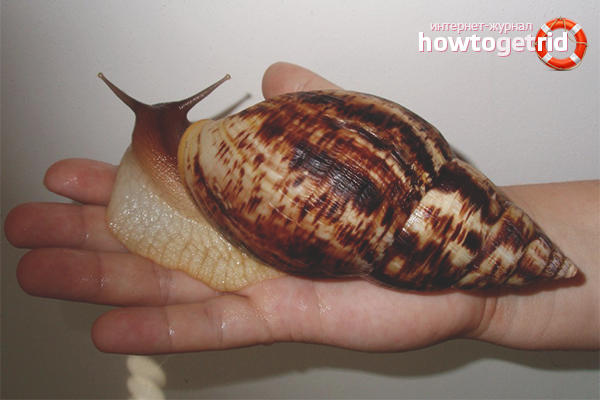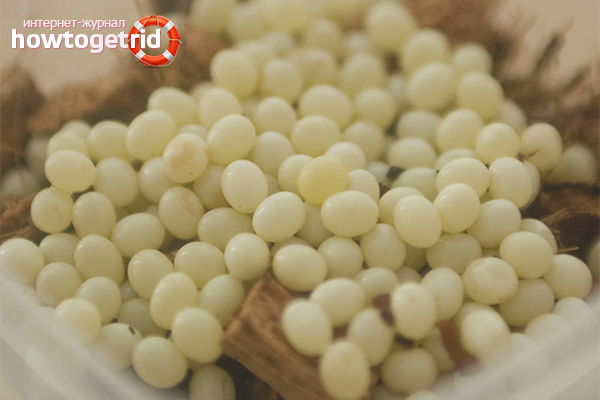The content of the article
Achatina are large snails belonging to the family Achatinidae, which, in turn, includes several genera. In some countries, this type of snail is recognized as a pest, as they easily destroy not only crops, but also buildings. In this way, the mollusk extracts chalk and lime for the construction of shells. However, it is the most popular type of snail for home breeding. Thanks to proper care, snails live for at least 10 years, and in size reach 20-30 cm.
Who can get such a pet
Akhatins are perfect for people who lead an active lifestyle or often go on business trips. Caring for these mollusks does not require constant attention, and besides, they can easily do without a meal for about a week. In this case, the snails simply hide in shells and hibernate. To wake them up, it is enough to moisten Achatina with water a little. However, to use such a unique ability of these snails too often is still not worth it.
Terrarium device
Usually these snails are kept in ordinary aquariums. At the same time, the size of the terrarium is taken into account - at least 10 liters must be provided for one individual. The larger the capacity, the larger the snail will reach. The aquarium should have a lid so that the mollusks do not crawl out of there. Therefore, for complete gas exchange, special holes are made in it. In extreme cases, you can slightly raise the lid of the terrarium, but the gap should not be too large.
At the bottom of the terrarium lies the litter. This is a special primer or coconut extract. It is poured with a layer of not more than 7 cm. For small snails, for the first time it is better to lay cabbage leaves. It is advisable to come up with a small bath inside the aquarium, as snails like to swim in the water. But it should not be deep, otherwise the mollusk can easily drown. And it must be stable and not overturned. You need to wash the aquarium once a week. If eggs are already laid in it, then cleaning occurs without water.
These evidence does not require special temperature or humidity. The conditions, like a regular city apartment, or a private house, are quite suitable for them. Soil moisture can be easily determined by the behavior of snails - if they sit on the walls of the aquarium, then the soil is too wet. If they constantly hide in shells, this indicates excessive dryness of the soil. When the humidity is normal, the mollusks will hide in the ground at night, and crawl from above during the day.
Feeding and hygiene
In food, snails Achatina are not picky and eat greens, fruits and vegetables. But in the natural environment, they can easily be eaten and meat. Most often, snails are fed carrots, cabbage or cucumbers, but it is better if the menu is more varied. You should not accustom a mollusk to one or several certain types of food, otherwise he will subsequently refuse to eat anything else.
Adult snails can easily cope with large pieces of fruit, but for kids it is better to rub them on a grater. It is not recommended to feed the mollusks with soft food, as it flows and spreads. Therefore, such food can only be given briefly, and then cleaned. From the menu of small snails, soft food is generally better to exclude.
It is necessary to feed snails with the following vegetables:
- zucchini;
- pumpkin;
- Champignon;
- cucumbers
- boiled potatoes;
- Tomatoes
- broccoli;
- cabbage leaves.
Of fruits and berries, it is better to give preference:
- Apricots
- apples
- pears;
- bananas;
- strawberries and strawberries;
- cherry;
- watermelon and melon;
- grapes, plums, etc.
In addition, snails can perfectly eat peas, oatmeal or beans, both raw and boiled.From time to time, you can give Achatina mushrooms, herbs, including nettles, dandelions, plantain, flowers of fruit trees, etc. Dairy products, eggs and minced meat will be useful in small quantities.
It is strictly forbidden to feed snails sour, sweet, salty, fried, as well as pasta. Do not forget that mussels really need a lot of calcium, so you should give them special cereals. In the terrarium there should always be a container with fresh water for drinking, but not very deep, otherwise the snails may drown.
Sometimes Achatina need to be washed. Many owners of mollusks combine such bathing with washing the aquarium. These mollusks are very fond of water, so there will be no difficulties with this procedure. It is better to wash them under a warm shower, controlling that the water pressure is not very strong. Otherwise, the mollusk will simply be scared.
Health
Achatina are exotic mollusks living in African countries, therefore, they are often carriers of various diseases. Therefore, you should be wary of snails imported from hot countries. It is best to purchase domestic, specially bred snails. But with them you need to follow the rules of hygiene.
As for the health of the Achatina themselves, they are rather delicate creatures. It is not recommended to plant mollusks of other species together with them, especially wild grape snails, as they can infect Achatina. No need to panic if a snail, for example, has broken off a piece of the shell. It is enough to lubricate the edges with an antiseptic and wait until the wound is healed itself.
Most often, Achatina suffer from:
- Temperature exposure. This is overheating or hypothermia of the mollusk, which can inhibit its development and growth.
- Chemicals. It is better not to use household chemicals when caring for the aquarium, etc. Snails most often die from contact with such preparations.
- Losses from the sink. Infections and fungi lead to shell loss. In a small snail, it can still grow, but adult individuals die.
- Household sink injuries. This may occur due to careless handling of the snail.
- Parasites. In this case, the snail becomes covered with white coating and stops eating. As a treatment, a pesticide for reptiles is used. And you definitely need to clean the aquarium.
- Worms. At the same time, the mollusk can be infected by worms from a person. For treatment, you need to feed him pumpkin seeds, cucumbers and chamomile.
- Infections. Such a disease in 95% of cases ends in the death of snails. Therefore, it is important to observe the correct mollusk conditions.
- Neoplasms. They can appear on the body of snails due to household chemicals, poor-quality aquarium materials, soil and harmful pesticides in foods. It is almost impossible to cure a tumor, therefore it is better to freeze a snail.
Breeding Achatina
Adult snails are capable of breeding upon reaching 7–9 months. And this process does not depend on the time of year. Under favorable conditions, the incubation period lasts several weeks. Then the eggs are laid. One snail can lay up to 400 eggs at a time. The offspring appears after about 1-2 weeks. If the snails do not breed for a long time, it is possible that they do not have enough space. The thickness of the substrate should be at least 3-4 cm. In addition, there are live-bearing species of mollusks.
Not everyone knows that Achatina are hermaphrodites, that is, they can act as mom and dad. If snail breeding is not planned, it is better not to buy a pair. If the eggs nevertheless appeared, then it is better to carefully pick them up and give Achatina to familiar owners. It is not recommended to release small snails into nature, as they are quite capable of causing enormous harm to the environment. In some countries, for example, in the UK, there are even administrative penalties for this.
Walks
Akhatins most often sleep during the day, so there is no need to worry if they burrow into the ground or hide in a sink. But how to play with your pet. Snails are not designed to be disturbed too often. They are very easy to injure, so even pick them up you should be careful. Before you put the snail in your palm, you need to moisten his leg with water and hold its shell during transfer. Do not pull the clam by the sink, as you can tear it.
They climb the skin with pleasure, while you can feel light tingling. In addition, the unique cosmetic properties of these snails have long been known. You can let the snail crawl around the apartment, but it is important to monitor it and keep it in sight all the time. Despite the fact that the mollusk moves at a speed of about 1 cm per minute, it is easy to overlook. And, most likely, the snail will creep into an inaccessible place and therefore it will be almost impossible to find it.
Achatina are not picky, almost omnivorous and do not require much attention. Nevertheless, they need to be monitored, carefully handled and then they will delight the whole family for a long time.
Video: care and maintenance of snails Achatina













Submit